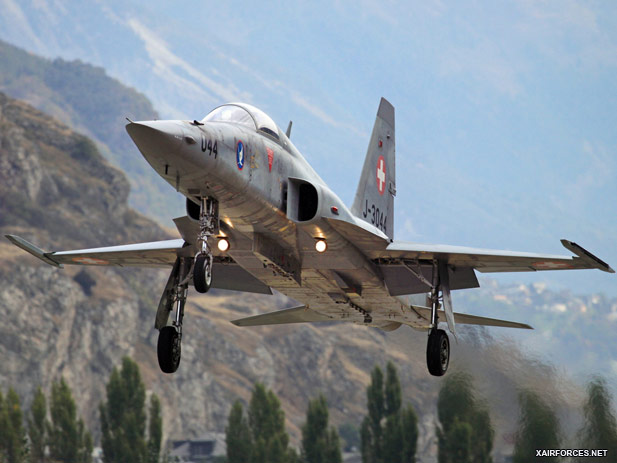
RUAG Eyes Swiss Air Force F-5E Tiger II Upgrades

Just over 55 years ago, a new Northrop engineer named Welko Gasich became one of the first aircraft designers to define a concept called “life cost,” ideas he picked up from Rand Corp., his previous employer. At the time, the size and cost of fighters were increasing with every new design, and new ones were rolled out every year. Smaller air forces, particularly U.S. allies getting into the jet age with F-86 Sabres, didn’t need—and couldn’t afford to fly-15-ton Mach 2 fighters.
Gasich and his team wrapped a minimalist two-gun, two-missile fighter around two high-performance engines that General Electric designed for the McDonnell Quail decoy missile. It used modern materials and design technology—including an early venture into a damage-tolerant structure—but was inherently simple, with a modular airframe.
Militaries ignored the fighter. The U.S. Air Force, however, was noticing how many pilots were crashing on early sorties with its Mach 2 aircraft, and discovered a need for a high-performance trainer. Once Northrop’s T-38 was in service, USAF looked around again, saw how few air forces could afford the now-25-ton fighters of the 1960s, and ordered the company’s single-seat F-5 for its Military Assistance Program.
Gasich became Northrop’s chief engineer. The F-5 had an even longer career, and it is some way from being over.
RUAG Aviation, which looks after Switzerland’s F-5E/F fleet, says the number of operational F-5s in the world has increased in recent years. The company carried out an analysis of alternatives for the Swiss defense ministry, which is considering putting off a buy of new fighters (Rafales, Typhoons or Gripens) and settling for an F-5 upgrade and another decade of operations.
RUAG would like to use that as a springboard to expand its worldwide F-5 business—it supports a lot of the international fleet of F-5E/F J85-GE-21 engines, and is thinking of moving into earlier versions. The company would expect to team with an avionics integrator (such as Elbit, which led an F-5E upgrade for Brazil) and systems suppliers.
What RUAG brings is the ability to support engines, airframes, systems and software, as well as its close relationship to an experienced F-5E operator—Switzerland.
Reasons for the F-5’s longevity are apparent around RUAG and Swiss air force facilities. In the maintenance shop, the boat-tail section of an F-5E—including the horizontal stabilizer—has been removed by popping small access panels and removing four bolts. The section rests on a hand-adjusted trolley. No hydraulics are involved because the stabilizer actuator stays with the aircraft. The engines are hung from overhead rails, engine-to-airframe connections are minimal, and the engine rolls on to another cart with a matching rail. The one-piece wing is held in place by four bolts and fits on a truck or railcar, making it easy to work on the wing and body in parallel.
Several Swiss F-5s are resplendent in red and white, the country’s aerobatic team. The pilots are part-timers: some fly the Boeing F/A-18 Hornet, and some are reservists. This is testimony to the fact that the F-5 is easy to fly and free of the nasty habits that afflicted its mostly retired contemporaries. RUAG sees a future for the F-5 as a lead-in fighter trainer, particularly as air forces find themselves with fewer and more costly first-line jets, some that aren’t even offered with two seats.
Unlike most trainers, the F-5 is, as one pilot says, a “real fighter”—supersonic, with afterburning and respectable climb and acceleration. “A nightmare to be in a dogfight with,” says one pilot. If the fight goes visual the F-5 often wins, because its smaller size means its pilot gets the first tally.
Operationally, homeland defense is the air force’s primary mission, and it does not take a 20-plus-ton bomber to do it. The main limitation of the aircraft, as delivered, is avionics: Swiss F-5s still have the original steam-gauge cockpit, Emerson radar that was not a world leader in 1972 and no head-up display, just a gunsight. Those would be candidates for change in an upgrade, along with installation of an autopilot and, probably, integration of a modern missile. Operationally, the Swiss air force wants the ability to close with and identify a target in all weather.
Switzerland’s decision on an F-5 upgrade is open. The defense professionals want to hold back and parliamentarians want to go forward with a new aircraft. But RUAG’s ambitions to become part of the fighter’s remarkably long life are firm.
Source: Emmen, Switzerland - Nov 3, 2011 - By Bill Sweetman (http://www.aviationweek.com)
Photo: Swiss Air Force F-5E Tiger II
(3.11.2011)
|